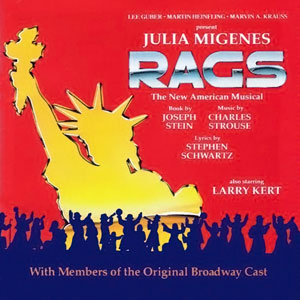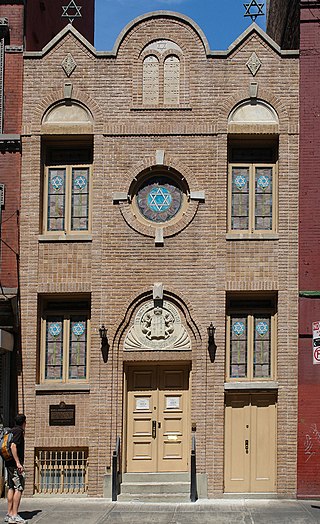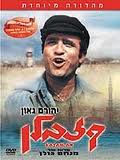
Mordecai Menahem Kaplan was an American Modern Orthodox rabbi, writer, Jewish educator, professor, theologian, philosopher, activist, and religious leader who founded the Reconstructionist movement of Judaism along with his son-in-law Ira Eisenstein. He has been described as a "towering figure" in the recent history of Judaism for his influential work in adapting it to modern society, contending that Judaism should be a unifying and creative force by stressing the cultural and historical character of the religion as well as theological doctrine.

The Lower East Side, sometimes abbreviated as LES, is a historic neighborhood in the southeastern part of Manhattan in New York City. It is located roughly between the Bowery and the East River from Canal to Houston streets. Historically, it was understood to encompass a much larger area, from Broadway to the East River and from East 14th Street to Fulton and Franklin Streets.

Israel Zangwill was a British author at the forefront of Zionism during the 19th century, and was a close associate of Theodor Herzl. He later rejected the search for a Jewish homeland in Palestine and became the prime thinker behind the territorial movement.
Harry Fischel was an American businessman and philanthropist based in New York City at the turn of the 20th century.

Rivington Street is a street in the New York City borough of Manhattan, which runs across the Lower East Side neighborhood, between the Bowery and Pitt Street, with a break between Chrystie and Forsyth for Sara D. Roosevelt Park. Vehicular traffic runs west on this one-way street.

Salome of the Tenements is a 1925 American silent drama film adapted to the screen by Sonya Levien from the Anzia Yezierska novel of the same name. Made by Jesse L. Lasky and Adolph Zukor's Famous Players–Lasky Corporation, a division of Paramount Pictures, it was directed by Sidney Olcott and starred Jetta Goudal and Godfrey Tearle.
Joan Micklin Silver was an American director of films and plays. Born in Omaha, Silver moved to New York City in 1967 where she began writing and directing films. She is best known for Hester Street (1975), her first feature, and Crossing Delancey (1988).

The First Roumanian-American Congregation, also known as Congregation Shaarey Shomayim, or the Roumanishe Shul, was an Orthodox Jewish congregation at 89–93 Rivington Street on the Lower East Side of Manhattan in New York City. The congregation was organized in 1885 by Romanian-Jewish immigrants, serving the Lower East Side's large Romanian-Jewish community. The Rivington Street building, erected around 1860, switched between being a church and a synagogue and was extensively remodeled in 1889. The First Roumanian-American congregation purchased it in 1902 and again remodeled it.

Jewish-American organized crime initially emerged within the American Jewish community during the late 19th and early 20th centuries. In media and popular culture, it has variously been referred to as the Jewish Mob, the Jewish Mafia, the Kosher Mob, the Kosher Mafia, the Yiddish Connection, and Kosher Nostra or Undzer Shtik. The last two of these terms are direct references to the Italian Cosa Nostra; the former is a play on the word for kosher, referring to Jewish dietary laws, while the latter is a calque of the Italian phrase 'cosa nostra' into Yiddish, which was at the time the predominant language of the Jewish diaspora in the United States.

Rags is a musical with a book by Joseph Stein, lyrics by Stephen Schwartz, and music by Charles Strouse.

Kehila Kedosha Janina is a synagogue located at 280 Broome Street between Allen and Eldridge Streets in the Lower East Side neighborhood of Manhattan, New York City, New York, United States.

Lee Kohlmar was a German film actor and director. He appeared in more than 50 films between 1916 and 1941. He also directed nine films between 1916 and 1921. He was born in Forth and died in Hollywood, California, from a heart attack. Fred Kohlmar was his son.

Jews comprise approximately 10% of New York City's population, making the Jewish community the largest in the world outside of Israel. As of 2020, over 960,000 Jews lived in the five boroughs of New York City, and over 1.9 million Jews lived in the New York metropolitan area, approximately 25% of the American Jewish population.

Kazablan is an early Israeli Hebrew language play, staged first as a 1954 drama followed by a 1964 screen adaptation, later as a 1966 musical comedy, and still later produced as a 1974 musical comedy film. The name Kazablan comes from Casablanca, the birthplace of the main character.

As of 2020, the Jewish population in New York State was 1,598,000, accounting for 21% of all Jews in the United States. In New York City alone, there are approximately 960,000 Jews, establishing it as the largest Jewish community in the world, surpassing the combined totals of Tel Aviv and Jerusalem.

The Jewish community of the Greater Cleveland area comprises a significant ethnoreligious population of the U.S. State of Ohio. Jews from Bavaria immigrated in the 1830s and its size has significantly grown in the decades since then. In the early 21st century, Ohio's census data reported over 150,000 Jews, with the Cleveland area being home to more than 50% of this population. As of 2018, Greater Cleveland is the 23rd largest Jewish community in the United States. As of 2023, the Cleveland Jewish Community is estimated to be about 100,000 people.

The Jewish-American patronage of Chinese restaurants became prominent in the 20th century, especially among Jewish New Yorkers. It has received attention as a paradoxical form of assimilation by embracing an unfamiliar cuisine.
The history of the Jews in Atlanta began in the early years of the city's settlement, and the Jewish community continues to grow today. In its early decades, the Jewish community was largely made up of German Jewish immigrants who quickly assimilated and were active in broader Atlanta society. As with the rest of Atlanta, the Jewish community was affected greatly by the American Civil War. In the late 19th century, a wave of Jewish migration from Eastern Europe brought less wealthy, Yiddish-speaking Jews to the area, in stark contrast to the established Jewish community. The community was deeply impacted by the Leo Frank case in 1913–1915, which caused many to re-evaluate what it meant to be Jewish in Atlanta and the South, and largely scarred the generation of Jews in the city who lived through it.

Suzanne Wasserman, was a Chicago-born historian, Professor, writer, and film director. Besides her tenure as Director of the Gotham Center for New York City history, she was also known for her first film, completed in 2003, Thunder in Guyana, which she wrote, produced, and directed. The film documented the life of her mother's first cousin, Chicago-born Janet Rosenberg Jagan, the president of Guyana from 1997 to 1999.
Benjamin Hoffman was a Jewish-American lawyer, politician, and judge from New York.
















